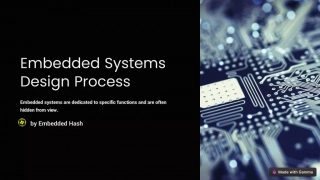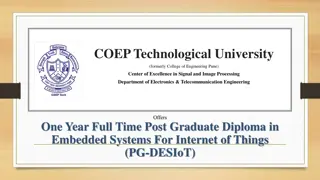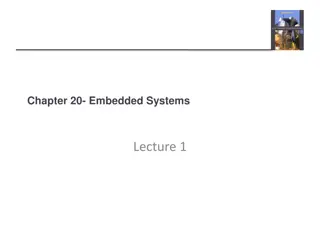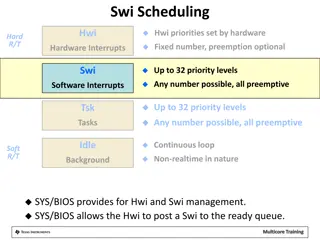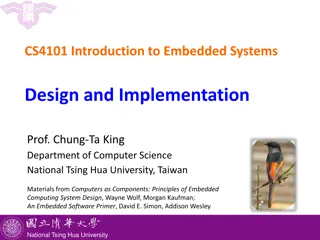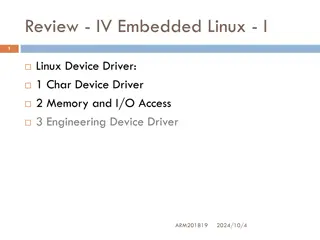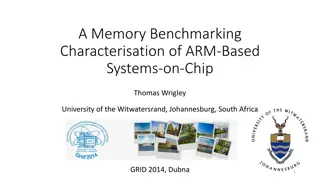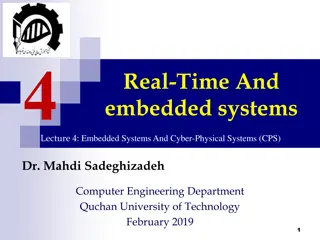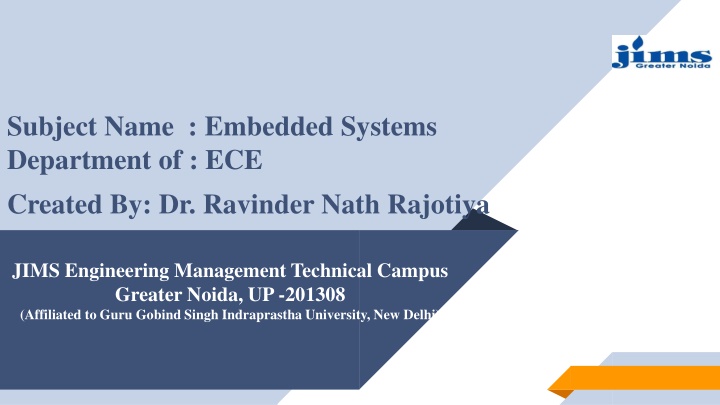
Comparison of Embedded Systems Microcontrollers - ARM, PIC, AVR, 8051
Explore the differences between popular microcontroller families: ARM, PIC, AVR, and 8051. Learn about key criteria for selecting a controller, such as speed, memory, interfaces, and more. Understand the features, architectures, and power consumption of each, aiding in choosing the right microcontroller for your embedded system project.
Download Presentation

Please find below an Image/Link to download the presentation.
The content on the website is provided AS IS for your information and personal use only. It may not be sold, licensed, or shared on other websites without obtaining consent from the author. If you encounter any issues during the download, it is possible that the publisher has removed the file from their server.
You are allowed to download the files provided on this website for personal or commercial use, subject to the condition that they are used lawfully. All files are the property of their respective owners.
The content on the website is provided AS IS for your information and personal use only. It may not be sold, licensed, or shared on other websites without obtaining consent from the author.
E N D
Presentation Transcript
Subject Name : Embedded Systems Department of : ECE Created By: Dr. Ravinder Nath Rajotiya JIMS Engineering Management Technical Campus Greater Noida, UP -201308 (Affiliated to Guru Gobind Singh Indraprastha University, New Delhi)
Subject : Embedded Systems Topic: : L-12 Comparison ARM and PIC
Index 1. General Criteria for selection of controller 2. Difference among various Controllers 3. Developers Point of Vieu
Some Criteria for Selection Depending upon the need of project to compare the two, look at the following parameters such as, Frequency: Speed at which the microcontroller will operate Number of I/O pins : Required ports and pins RAM: All the variables and arrays declared(DATA) in most MCUs Flash Memory: Whatever code you write goes here after compiling Advanced Interfaces: Advanced interfaces such as USB, CAN and Ethernet. Working Voltage: Working voltage of MCU such as 5V, 3.3V or Low voltage. Target Connectors: The connectors for ease of circuit design and size.
Difference between AVR, ARM, 8051 and PIC Microcontrollers http://www.firmcodes.com/difference-arm-microcontrollers/ 8051 PIC AVR ARM 8-bit for standard core 32-bit mostly also available in 64-bit 8/16/32-bit 8/32-bit Bus width UART, USART, SPI, I2C, (special purpose AVR support CAN, USB, Ethernet) UART, USART, LIN, I2C, SPI, CAN, USB, Ethernet, I2S, DSP, SAI (serial audio interface), IrDA UART, PIC, UART, USART, LIN, CAN, Ethernet, SPI, I2S Communication Protocols USART,SPI,I2C 12 Clock/instruction cycle ROM_ SRAM_ FLASH 4 Clock/instruction cycle 1 clock/ instruction cycle 1 clock/ instruction cycle Speed SRAM_ FLASH Flash_ SRAM, EEPROM Flash-SDRAM, EEPROM Memory CLSC Some feature of RISC RISC RISC ISA Von Neumann architecture Memory Architecture Power Consumption Harvard architecture Modified Modified Harvard architecture medium Low Low Low
PIC16,PIC17, PIC18, PIC24, PIC32 Very Good Tiny, Atmega, Xmega, special purpose AVR Very Good ARMv4,5,6,7 and series 8051 variants Families Vast Vast Community Apple, Nvidia, Qualcomm, Samsung Electronics, and TI etc. NXP, Atmel, Silicon Labs, Dallas, Cyprus, Infineon, etc. Microchip Average Atmel Manufacturer Cost (as compared to features provide) too Low medium medium Low High-speed operation Vast LPC2148, ARM Cortex-M0 to ARM Cortex-M7, etc. Known for its Standard Cheap Cheap- effective Other Feature PIC18fXX8, PIC16f88X, PIC32MXX AT89C51, P89v51, etc. Atmega8, 16, 32, Arduino Community Popular Microcontrollers
Size of Project That MPlab X isn't working for large projects and I can't believe that any one serious is using it For the PIC32 you are stuck to Microchip unless you are willing to pay 1800 euro's for an Opella E- Jtag interface. ARM has far better tools support Extra cost for interface like E-Jtag for debugging support For the ARM, AVR32 or MSP430 you have affordable solutions to get a GDB debugging up and running so you are free to use the tools that you like. Need less space for target code Space for code The PIC32 needs more code space then the ARM target (upto 35% more). The PIC32 is running smoother then the NXP ARM target. That MPlab X isn't working for large projects and I can't believe that any one serious is using it Runtime Behaviour NXP ARM does not run as smooth as PIC32 Size of Project ARM has far better tools support
References Debug features For a large project with a lot of console logging in debug build, PIC32 is not workable. The ARM has far better debug features. The ARM debug printf (to an output console) is working very fast compared to the PIC32. Lesser RAM RAM Pricing becomes comparable but a major PIC32 advantage is the large RAM The big dilemma with PIC projects is that they seldom get involved with high volume production, our application is not likely to get to 10K units, so NRE costs need to be manged closely. Volume of Production ARM are suitable for large volume of production
References Support for C++ and RTOS Microchip has no support for C++ (nor does it seem do the third parties) and no RTOS. The tool chain is behind the times. The application we are looking at has a defacto standard protocol stack is written in C++ and expects a premptable scheduler. ARM lacks this support TCP/Ethernet and RS232, Flash etc Given an application that needs to terminate TCP over Ethernet and RS232, it seemed that a PIC processor with Ethernet support would be a natural fit. The PIC32 has the peripherals, plenty of computes, FLASH and RAM

